In Wamena in Papua’s Jayawijaya regency there is a customary belief that women and children are innocent, that’s why the men have to protect them. “Humi yukurugi wene inyokodek,” said Dominikus Surabut, head of the customary council of La Pago. But if women and children become victims, he said, the men are going to fight in the afternoon and evening. “Inyawim hiam-hiam ninane uok...,” Dominikus went on.
By: Victor Mambor and Syofiardi Bachyul
The Jakarta Post
This belief played a role in the events that took place in Wamena on Sept. 23, a tragedy shInrouded in mystery amid a communication blackout in the region.
According to statements from the government, at least 33 were killed in the violence, eight of them native Papuans. An armed rebel group – referred to as an “armed criminal group” by the police – was reportedly behind the atrocity. Thousands of people, both native Papuans and non-native residents, fled the town following the riot.
The police said the non-native Papuans had died in fire while some had sustained injuries from sharp weapons. The official statement said nothing about what had caused the death of the native Papuans.
On Oct. 2, security and terrorism researcher Sidney Jones of the Institute for Policy Analysis of Conflict (IPAC) published a piece on Lowy Institute website, saying that “nine Papuans also died, mostly stabbed by migrants trying to fend off the mob.” Sidney told the Post on Oct. 23 that she had got the information from a hospital in Wamena.
The Jakarta Post and several journalists from Jayapura-based Jubi and Jakarta-based Tirto.id conducted an investigation in the field in Wamena in Jayawijaya from Oct. 3 to 10 and discovered what the government has failed to reveal.
One of the most important pieces of information is that more than eight native Papuans died that day and that they died of gunshot wounds allegedly inflicted by what locals call “security apparatus”, a joint force of Indonesian Military and National Police personnel.
The National Police said there had been an exchange of fire between security officers and an “armed criminal group” that day. Cendrawasih Military Command spokesperson Lt. Col. Eko Daryanto echoed the police’s statement.
The Post and other journalists talked to more than 30 witnesses in Wamena about what happened during the riot. They were native and non-native residents, including religious figures, restaurant workers, traders, students and activists who were at the location that day.
Witnesses said they first noticed a crowd numbering in the hundreds on Jl. Hom-Hom in Wamena at about 8 a.m. on Sept. 23. Some people gathered in front of Yudha Supermarket in Hom-Hom while others gathered nearby.
The protest turned violent after a young man, later identified as Kelion Tabuni, a sophomore at the Manado State University in North Sulawesi, was allegedly shot by security personnel in Hom-Hom at 8:30 a.m.
Kelion, who arrived in Wamena from Manado two weeks prior to his death, was standing among hundreds of people when he was shot. A number of people in the crowd wore high school uniforms, witnesses said. Locals living in the area said they did not recognize anyone in the crowd.
After Kelion was shot, people in his crowd carried his body while they were going on a rampage. They walked past a traders’ area called Pikhe and along the road were kiosks selling gasoline in bottles and jerrycans for motorcyclists.
The mob stole fuel and burned down houses and stores on Jl. Pikhe. Witnesses said local residents had warned the people in the houses and stores, mostly non-native Papuans, to flee to save themselves from being burned alive. Pikhe became a place of heroic tales in which native Papuans helped hundreds of non-native residents.
One such person was Obet Mabel, who, together with other native residents, helped at least 58 families reach a safe place in the city center. Obet also said he did not recognize any of the rioters.
“The [non-native] Papuans then were brought to churches near a bridge in Pikhe,” said Simet Jikwa, a pastor at the Protestant Wesaroma Church. His church, along with the Kibaid and Panorama churches, provided shelter to hundreds of scared non-native Papuans that day.

A young man who requested anonymity shows a gunshot wound on his leg. He was shot when attempting to enter Wamena via the Wouma Bridge. (JP/Albertus Vembrianto)
‘I did not recognize a single face’
While some men carried away Kelion’s body and others set stores and houses on fire on Jl. Pikhe, some of the crowd headed for a campus in the Hom-Hom area, STISIP Amal Ilmiah Yapis, and set classrooms on fire. They also burned other properties on Jl. Hom-Hom and some non-native Papuans died after become trapped inside burning buildings.
Several witnesses said they did not recognize the faces of arsonists in Hom-Hom. They noticed that some of them wore high school uniforms, but they did not know anyone among the crowd.
The National Police said last month that the perpetrators of the arson and manslaughter were “not from Wamena”.
“We have asked [the National Police] to find out and investigate the allegation [that outside people mobilized the crowd],” National Commission for Human Rights chairman Taufan Damanik said in Jayapura.
He said the police had to explain how people moved and entered Wamena during the riot. “Where did they come from? How did they coordinate? They came from everywhere,” he said.
Obeth Alua, a Wamena resident who was on Jl. Hom-Hom on that day, said he did not recognize any of the people who gathered in the area. He claimed that Wamena, the busiest district of Jayawijaya, was a small town, and he should have recognized at least one or two of the people there.
“They said they were there for an antiracism rally. I recognized not a single one of them. And then I saw two people got shot and fell down, one man and one woman,” said Obeth, showing the Post where he stood that day and pointing to the location where he saw the shots.
Later, the Post confirmed that the man was Kelion Tabuni, but the Post could not confirm the female victim, who according to Obeth, was taken into the direction of Wesaput.
Jayawijaya Police chief Adj. Sr. Comr. Tonny Ananda said the student rally had been infiltrated by an armed group that led to “crossfire” between the armed group and the security forces.
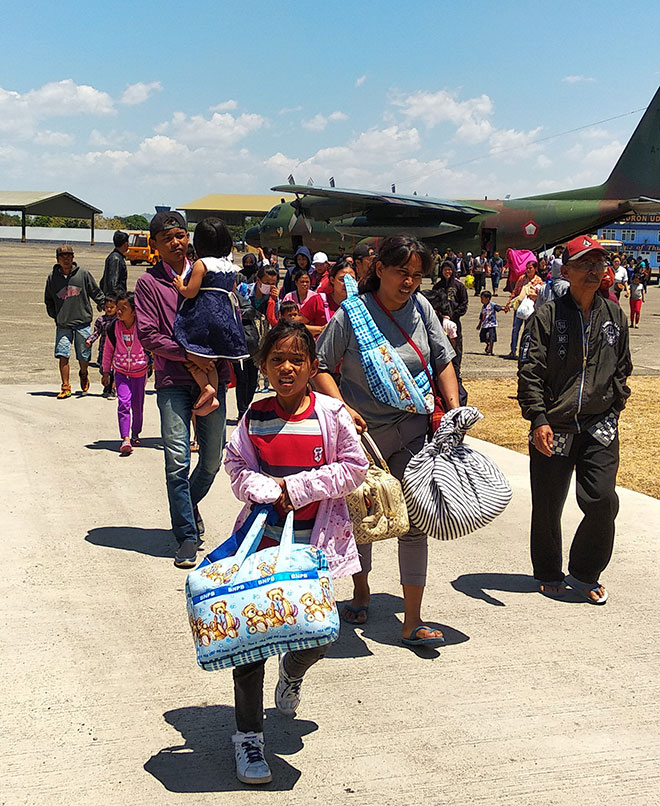
Evacuees wait their turn to board an Indonesian Military aircraft at Wamena Airport in Jayawijaya regency on Sept. 28 following a deadly riot on Sept. 23. (Antara/Iwan Adisaputra)
“During the rally, there was another mob behind the mob, and behind them there was the armed group. They were involved in crossfire from Monday to Tuesday morning,” said Tonny.
Up until this article was written, the government has never spoken about security forces opening fire at protesters.
They have, however, pointed fingers at the West Papua National Committee (KNPB), a self-determination activist group that has close affiliations to the proindependence movement.
Tonny said people from the KNPB had spread a “hoax” about a racial statement from a teacher. He said most of the perpetrators of the riot came from outside Wamena district. The police, he said, had been investigating “the groups”.
Hoax?
At the same time about 4 kilometers from Yudha Supermarket in Hom-Hom, students of PGRI high school on Jl. Bhayangkara in Wamena gathered at about 8 a.m. to protest against one of their teachers, Riris Theodora Panggabean. The students accused Riris of calling fellow student Anton Pahabol a “monkey” on Sept 18.
Michael Asso, a physical education teacher at PGRI, said the teachers had held a meeting on Sept. 21 to question Riris, but Riris denied she had made a racial statement on Sept. 18.
Debora Agapa, the deputy principal for student affairs, said nothing had happened at the school from Sept. 19 to 20.
On Sept. 21, however, students had damaged some school property. Heru, a cafe owner in Wamena, told the Post that his employee, a high school student at PGRI High School, had came home early, at 10 a.m. on Saturday. Heru had asked her and she had said one of her teachers had called a friend “monkey”, and then the students had broken the windows and computers at the school office,” she said. That evening, she left Wamena for her hometown in Yahukimo regency. Later on Monday, Michael said, someone trespassed onto the school ground and damaged a classroom.
Angry students
A teacher at another school, Kartini, told the Post that she had received a text before Monday about the rumor emanating from PGRI high school. She had heard the rumor through a WhatsApp message that called on other students to rally to protest the alleged racism on Monday.
She said not long after 8 a.m. at her school, SMK Yapis vocational high school — located next to the Jayawijaya regent’s office — a crowd, some wearing high school uniforms, others not, threw stones at the school.
Another school, SMA 1 state senior high school in Wamena, was attacked. Three teachers, all native Papuans, told the Post that about 900 students were attending class to sit a test. Sometime after 8 a.m., hundreds of students from outside “swarmed like bees” and called on the students in the classroom to rally with them. They also threw stones at the windows, hurting some of the students.
Papua Governor Lukas Enembe told the Post on Oct. 1 that he had received reports about three junior high school students, native Papuans, who had been doused with gasoline and set on fire by the rioters because they refused to join a rally. “Those who set the children on fire wore high school uniforms, and what they did was cruel,” he said. Media reports said the student victims were from SMP 1 state junior high school in Wamena.
Students that look too old
On Monday morning, police officers arrived to meet the students at the high school, a teacher said. The officers tried to calm down the students, who were angry because they could not speak with Riris, and the police asked them to settle the matter at the Jayawijaya Police station.
So they walked to the police station, and along the way they called on other students to join them, some by force.
While the students walked to the regent’s office, shops in Pikhe and Yapis campus in Hom-Hom had already been set on fire by the other crowd.
Fires were reported in many places, including at Potikelek, located south of Jl. Hom-Hom. Security personnel fired tear gas in Potikelek, witnesses said.
When students reached the regent’s office, they gathered in the front yard to wait for the regent. Local journalist Naftali Pawika said he had received information that the regent was out of the office at the time to assess the situation in Hom-Hom.
When Regent John Banua Rouw arrived, the students delivered their demand that seven school mates be released.
“They also wanted no security forces in the regent’s compound while they were there, and they did not allow anyone to take pictures,” said Dominikus Surabut, the La Pago customary chief.
Naftali said when the regent was talking to the students, someone took pictures of the students, who became angry and chased after the person. But the man left the compound in a car.
“Not long after, while the students were still in commotion due to that man, the regent’s office finance building, located at the very back of the compound, was on fire,” he said.
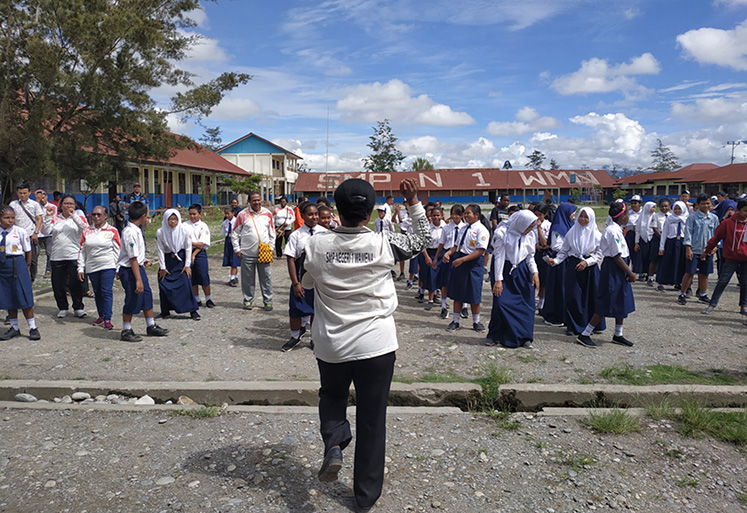
The principal of SMP 1 state junior high school in Wamena, Yemima Kopeuw, guides her students in dance to eliminate anxiety on the first day back at school on Oct. 7. (JP/Syofiardi Bachyul Jb)
Fire trucks came but the students blocked the trucks, because they did not want the firefighters to extinguish the fire. Tension flared up and the students at the front yard of the compound threw stones at the regent’s office building. Chaos ensued and people ran away from the chaos.
“The fire grew bigger and, I don’t know how, caught other buildings separated from the finance office building. At the end, only one building survived,” he said.
At this time, native Papuan women and children fled the town for kampungs surrounding Wamena.
Chaos in Wouma
While fire was raging at the regent’s office, some of the crowd headed toward the airport to set it on fire, but the security forces intercepted them with tear gas. So they instead went to Wouma, where chaos broke out.
At the same time, witnesses said another crowd began to gather on the fringe of town; they were people from kampungs who had heard rumors that their children who went to school in the city center had been shot by security forces and arrested by the police.
People said the fact that Papuan women and children had fled the town for kampungs had prompted the men in the kampungs head into town.
Many students in Wamena hail from other districts in rural Jayawijaya, a regency that is home to the famous Baliem Valley. They usually stay in rooming houses in Wamena, away from their parents, during the school week.
“We heard that our children had been arrested by police and some had been shot. We also heard the students wanted to go to the airport to burn it down,” said Alex Asso, the elder brother of Yus Asso, one of the native Papuans who was shot dead in the riot.
Parents and family members of Wamena students left their villages and headed for Wamena but were stopped by security forces at the Wouma Bridge.
On the other side of the Wouma Bridge, the crowd at the regent’s office had grown larger and angrier. Mus Mulyadi, a satay restaurant owner, said he saw men dressed in high school uniforms.
“Those who set the kiosks on fire were all men who did not look like students. One had a beard this long,” he said, gesturing to indicate the length.
One witness, who requested anonymity, said security personnel had fired shots here. He was injured by one of the shots before he could reach the town.
The shots made the crowd even angrier and they set alight stores and kiosks in Wouma. Witnesses said more victims were killed here, because the mob did not bother to check whether there were people inside the buildings. Some non-native Papuans were also reportedly stabbed by members of the mob.
Data from the police and the Post’s investigation show that at least 42 died because of the riot. Thousands of people, native and non-natives Papuans, fled Wamena, some flew out of the island and went back to their hometowns in places like West Sumatra and South Sulawesi.
The Post’s investigation revealed many things that had not been published before. But still, some questions are left unanswered: Who were the crowd at Hom-Hom? Why were they there? Was any armed group involved as the police said? The dozens of witnesses did not mention seeing armed civilians.
Komnas HAM commissioner Taufan Damanik said the police and the Indonesian Military had to investigate what really happened there. "So, we don't miss any [facts]," said Taufan.
Governor Lukas said he believed the riot had been planned, not by residents of Wamena nor the Baliem Valley people. He believed the perpetrators pretended to be high school students. “This happened by design,” he said. “But we don’t know who, and it is difficult to prove.”
Whether the riot happened by design or not, it has strained the relationship between the nonnative and native Papuans in Wamena. La Pago customary council chief Dominikus Surabut said in his apology to non-native Papuans that the situation took them by surprise and “was out of their control”. He said they helped all those they could help that day, but he was sorry that they could not help all.
“Let’s build [Wamena] together. We eat from the same plate, we sit side by side, building lives. I cannot prevent [non-natives] from leaving Wamena, but for you who come back, let’s build Papua together, in particular Baliem. For native Papuans, it is our belief that when we say we are best friends, it is not only [empty] words,” he said in a video interview with the Post on Oct. 4. “Before you shed your blood, we will shed ours first [to protect you].
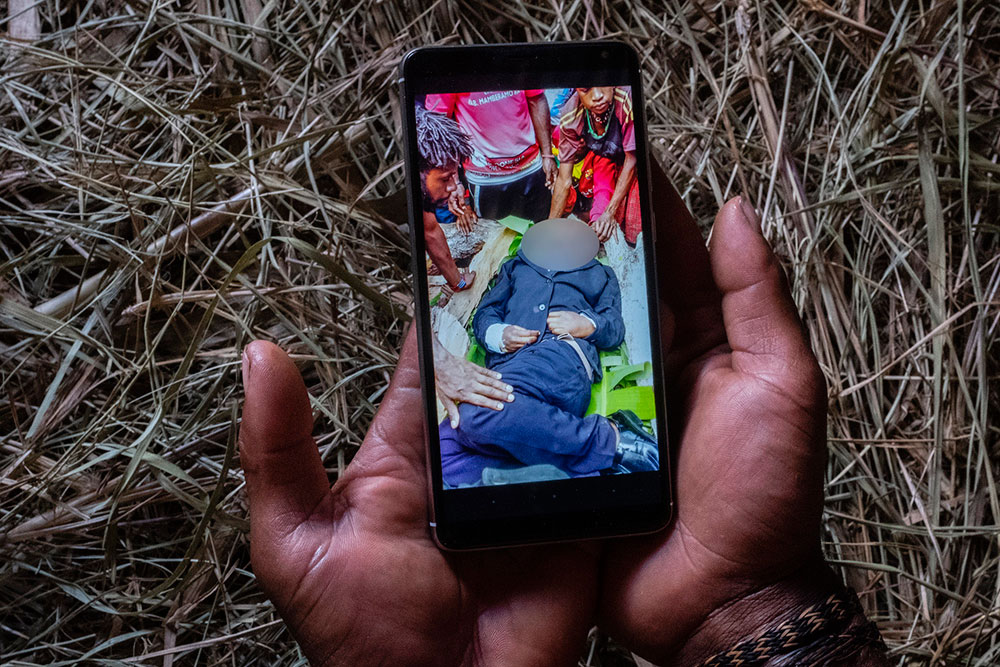
Shot, wounded and dead: Wamena riot death toll remains shrouded in mystery
On Monday, Sept. 23, Amandus, took his son on a motorcycle to SMA YPPK Santo Thomas senior high school in Wamena, Jayawijaya, Papua. When they arrived, his son got off and went to his class while Amandus went to park his motorcycle because he needed to meet his son’s teacher. Not long after he left the bike, he heard gunshots.
“Children were running out of the classrooms, including my son. He saw me and he ran to me,” Amandus, a resident of Pisugi district, said.
He did not quite understand what was happening. The commotion continued and he heard gunshots getting nearer the school. The students ran in panic, knocking his motorcycle to the ground. He pulled his son’s arm, ran outside the school and hid in his relative’s house not far from the school.
From the house, he peeked out. He heard people yelling amid the gunshots.
“I tried to look from the open door. Suddenly I felt pain in my thumb and my thigh. I fell. I was shot and the bullet was in my thigh,” Amandus said in Wamena.
17 reported dead from gunshots
Amandus was lucky, he was taken to the hospital immediately, received emergency treatment and was flown to the provincial capital in Jayapura for surgery. Others were not so lucky.
A young man who requested anonymity told The Jakarta Post he was shot in his thigh on Wouma bridge, when he tried to enter Wamena after hearing that high school students were being arrested and shot. He never got to Wamena and went home to treat his wound. But he was at least alive.
Naligi Wenda, Keitron Kogoya, Eles Himan, Yus Asso, Mison Lokbere, Marius Wenda, Manu Meage, Elakim Wetapo, Gestanus Hisage, Kelion Tabuni and Lawan Hesegem did not survive.
Naligi was a security guard at Yudha Supermarket on Jl. Homhom, the place where the earliest crowd was spotted by witnesses on the day of the bloody riot. He was reportedly shot near Wouma bridge, about 4 kilometers from his workplace. His family said that day he did not work but he went to Wouma on his way to the airport. He was shot dead, his family told the Post.
Keitron Kogoya suffered the same fate. He was reportedly shot near Wouma bridge. Neither he nor Niligi ever reached the hospital; that was why their names do not appear on the official list. From the killing zone in Wouma, their family members took their bodies home and cremated them as is their tradition.
“My uncle went to his campus, STISIP Amal Ilmiah Wamena, to finalize his thesis topic. In the afternoon, we heard that he was dead from a gunshot wound to the hip,” Iton Pahabol told the Post about the fate of his uncle, Eles Himan.
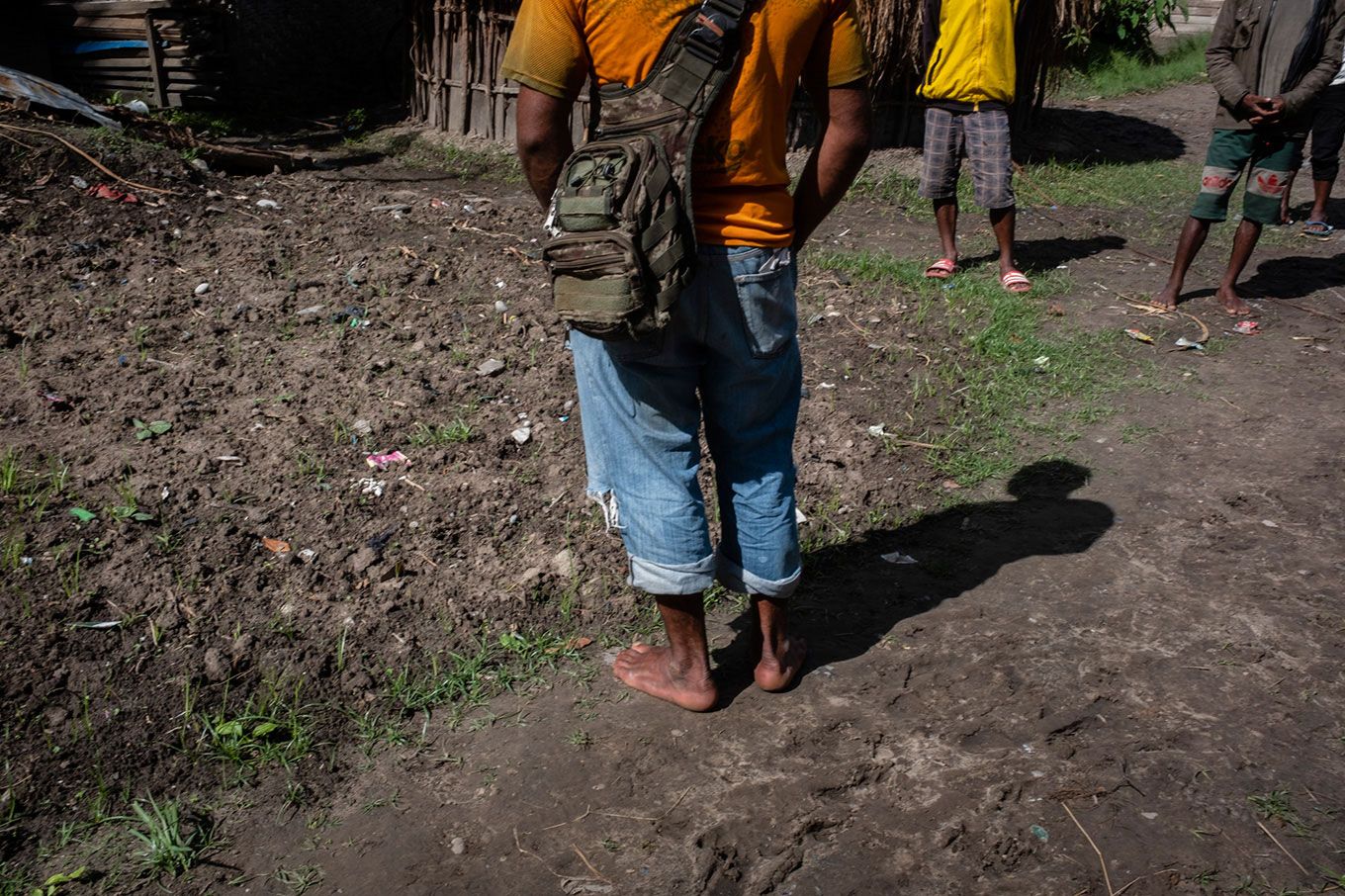
A man stands at the location of Eles Himan grave, one of the dead victims among native Papuans. (JP/Albertus Vembrianto)
Eles, he said, was found by family members in Wamena Regional Hospital (RSUD Wamena). The body was dressed only in pants.
Yus Asso, a Kampung Megapura resident, was reportedly shot in Wouma. Yus was still alive when he was taken to the hospital, said his brother, Alex Asso, but he was not able to see Yus before he died. “They did not allow men to enter the hospital, only the women,” he said.
Brought home directly
Alex said the bodies of several people that had been shot were taken to the hospital. Many of those who were shot and injured did not go to the hospital for treatment because they were afraid of the police and military guarding the hospital. Most of them were afraid of being arrested if they went to the hospital for treatment. They heard stories about the police rounding up injured victims, naming them suspects and detaining them.
“Ruben Esema, a student, is now detained in Jayawijaya Police. When his family members went to take him home from the hospital after surgery for his gunshot wounds, he had already been taken into police custody,” Alex said.
A similar fate befell Anderson Uaga, a student at SMA 1 high school Wamena. He was shot in his stomach. After getting treatment at RSUD Wamena, Anderson was taken by the police on Sept. 30. He is still detained and receiving medical treatment at Jayawijaya Police’s health clinic.
Papua Police spokesperson Sr. Comr. AM Kamal said on Oct. 7 that the police had named 13 people suspects in the Wamena riot. Three are still at large, those detained have been identified only as DM, 19, RW, 18, AU, 16, RA, 16, AK, 19, DC 32, YP, 22, ES, 27, NT, 27, and SK, 40.
La Pago Customary Council chief, Dominikus Surabut, said he was certain the official data did not reveal everything. Many victims, dead or injured, were not on the official list.
The Customary Council held an extraordinary congress after the riot and collected information about eight people who were believed to have been shot dead but were not on the police list.
The Post and Jayapura-based Jubi also received information about one man who was shot dead during the riot. He has been identified as Nisaba Himan. His body was found in Pisugi with a gunshot wound in his chest.
Not on national media
From Oct. 3 to 8, journalists from the Post, Tirto.id and Jubi investigated claims by native Papuan residents that the police and the military fired into the crowd on Sept. 23. Many of them said families did not want to go to hospitals because they believed the hospitals were heavily guarded by the security forces, which for a lot of native Papuans means trouble. So, the Post went to villages quite far from the town center—Pisugi, Asotipo, Wesaput and Megapura—to verify the claims.
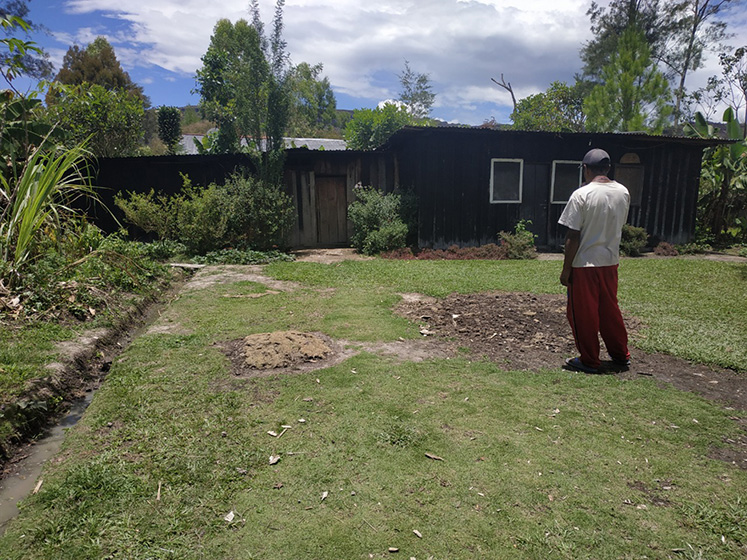
A family member shows the location where Kelion Tabuni was buried in Kampung Pisugi in Jayawijaya, Papua, on Oct. 7. (JP/Syofiardi Bachyul Jb)
These claims have been largely unreported by the national media. No one has said anything about security forces shooting into the crowd.
The Health Ministry has reported 33 fatalities in the riot. Twenty-six were dead on arrival at the hospital while five died in the hospital. An additional two victims died as a result of underlying conditions or illness but the government included them in the death toll because there was a suspicion that their deaths were related to the riot.
The government released 31 names from the death toll and eight of the names have been identified as probably being of native Papuans, while the remainder appear to be of people from other ethnic origins such as West Sumatra and South Sulawesi.
The government said the causes of the deaths of the 31 were fire and stabbing. On Oct. 2, Sidney Jones from the Institute for Policy Analysis of Conflict wrote on the Lowy Institute’s website that “nine Papuans also died, mostly stabbed by migrants trying to fend off the mob.”
Verified deaths and causes
The Post, in collaboration with Jubi and Tirto.id, however, has verified at least 11 native Papuans who died as a result of gunshot wounds. The Post received 17 names and nine were new names that were not on the government list. The eight native Papuans on the government list were verified too, and the family members have confirmed that they sustained gunshot wounds. Some were taken from the site directly to their homes to be cremated.
The National Commission of Human Rights said on Oct. 18 that it had discovered 10 additional fatalities apart from those the government published. Commissioner Beka Ulung Hapsara said the 10 people were reportedly shot dead but their names were not on the list because their families brought the bodies directly to their homes. “We still have to investigate this, it will not be easy to clarify and validate whether there are really additional fatalities outside the 33 published,” commissioner Beka Ulung Hapsara said in Jayapura on Oct. 12.
Eleven verified fatalities:
- Ketron Kogoya (shot in Wouma, on government list)
- Eles Himan (shot in Homhom, on government list)
- Yus Asso (shot in Wouma, on government list)
- Nison Lokbere (shot in Homhom, on government list)
- Marius Wenda (shot in Homhom, on government list)
- Manu Meage (shot in Wouma, on government list)
- Elakim Wetapo (shot in Homhom, on government list)
- Gestanus Hisage (shot in Wouma, on government list)
- Kelion Tabuni (shot in Homhom, on Papua Customary Council list)
- Naligi Wenda (shot in Wouma, on Papua Customary Council list)
- Lawan Hesegem (shot in Wouma, on Papua Customary Council list)
Six names from the Papua Customary Council and named locally, not yet verified:
- Nisaba Himan (shot and later found in Pisugi)
- Inius Tabuni (shot and later found in Baliem River)
- Beam Wenda (shot and later found in Tulem)
- Naligin Yikwa (shot in Homhom)
- Wenas Babingga (shot in Homhom)
- Yandrik Wenda (shot in Wouma)






